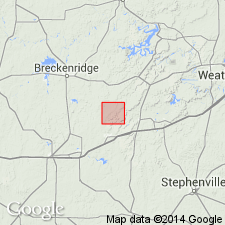
- Usage in publication:
-
- Gonzales limestone member*
- Modifications:
-
- Original reference
- Dominant lithology:
-
- Limestone
- AAPG geologic province:
-
- Bend arch
Summary:
Pg. G307. Gonzales limestone member of Cisco formation. Coarse-grained, dark-gray limestone, containing large numbers of CAMPOPHYLLUM. Thickness 0 to 4 feet. Lies 96 feet above Home Creek limestone and 80+/- feet below Bunger limestone. Stratigraphic position corresponds closely to that of Jacksboro limestone. Plummer finds Jacksboro thins to south and plays out near northern border of Lacasa area, leaving interval of nearly 40 miles over which neither bed has been traced; hence local name. To west replaced by shale. [Age is Pennsylvanian.]
Named from Gonzales Creek, Stephens Co., Brazos River region, central northern TX.
[GNC remark (ca. 1936, US geologic names lexicon, USGS Bull. 896, p. 836): The Cisco is now treated as a group in this area, divided into several formations, and Gonzales limestone is now treated as a member of Graham formation.]
Source: US geologic names lexicon (USGS Bull. 896, p. 836).
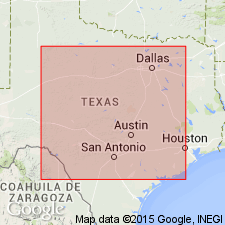
- Usage in publication:
-
- Gonzales limestone member*
- Modifications:
-
- Areal extent
- AAPG geologic province:
-
- Bend arch
Summary:
Pg. 18-19. Gonzales limestone member of Graham formation of Cisco group. Well exposed on high westward-facing bluff in south side of Brazos River and southeast of Salem Bend [Young County], where it is 18 feet thick. This is only place where complete unweathered section was noted in area of this report [Brazos River Valley]. Separated from underlying Salem School member (new) by unnamed interval of shale and sandstone; underlies sandstone interval below Bunger limestone member. [Age is Late Pennsylvanian.]
Source: US geologic names lexicon (USGS Bull. 1200, p. 1541).
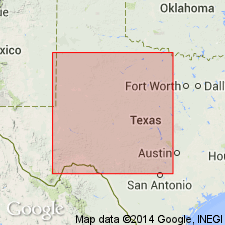
- Usage in publication:
-
- Gonzales formation
- Modifications:
-
- Revised
- AAPG geologic province:
-
- Bend arch
Summary:
Pg. 66 (fig. 1). Gonzales formation of Graham group. Shown on correlation chart as formation in Graham group. Includes Salem School limestone member. Occurs below North Leon formation and above Home Creek limestone in Caddo Creek group. Cisco raised to Series rank in this report. [Age is Late Pennsylvanian.]
Source: US geologic names lexicon (USGS Bull. 1200, p. 1541).
- Usage in publication:
-
- Gonzales shale
- Modifications:
-
- Revised
- AAPG geologic province:
-
- Bend arch
Roth, Robert, 1956, [Fig. 2, columnar section]: North Texas Geological Society Field Trip Guidebook, May 25-26, 1956, [20 p.].
Summary:
Fig. 2 (C.E. Davis). Shown on correlation chart as Gonzales shale in Caddo Creek group. [Age is Late Pennsylvanian.]
Source: US geologic names lexicon (USGS Bull. 1200, p. 1541).
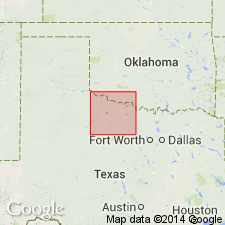
- Usage in publication:
-
- Gonzales Limestone [unranked]
- Modifications:
-
- Mapped
- AAPG geologic province:
-
- Bend arch
Summary:
Gonzales Limestone [unranked] in Cisco Group. Fine- to coarse-grained, platy to massive, sandy and argillaceous limestone exposed on shale slopes immediately below Gonzales Creek Member [of Graham Formation of earlier workers] in Cisco Group. Thickness 1 to 2 feet. Fossils (fusulinids, crinoids). Age is Late Pennsylvanian (Virgil).
Geographically restricted to southeastern Young Co., central northern TX.
Source: Publication.
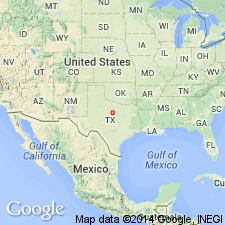
- Usage in publication:
-
- Gonzales Limestone Member*
- Modifications:
-
- Areal extent
- AAPG geologic province:
-
- Bend arch
Summary:
Gonzales Limestone Member of Graham Formation of Cisco Group. Limestone. Overlies Finis Shale Member and underlies Gonzales Shale Member, both of Graham. New brachiopod species ISOGRAMMA COOPI described; collected from exposures near the Mt. Zion Cemetery, La Casa quadrangle, Stephens Co., central northern TX. Age is Late Pennsylvanian (Virgilian).
Source: Publication.
For more information, please contact Nancy Stamm, Geologic Names Committee Secretary.
Asterisk (*) indicates published by U.S. Geological Survey authors.
"No current usage" (†) implies that a name has been abandoned or has fallen into disuse. Former usage and, if known, replacement name given in parentheses ( ).
Slash (/) indicates name conflicts with nomenclatural guidelines (CSN, 1933; ACSN, 1961, 1970; NACSN, 1983, 2005, 2021). May be explained within brackets ([ ]).

